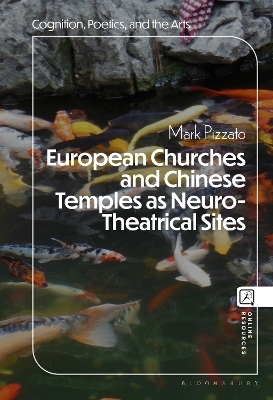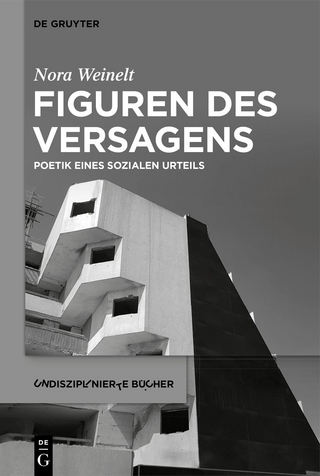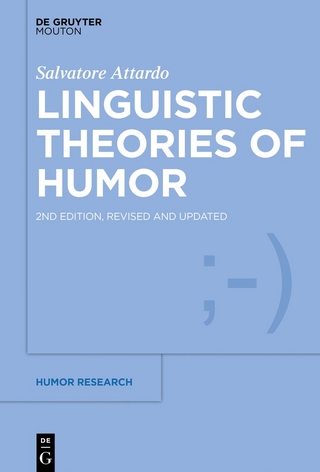
European Churches and Chinese Temples as Neuro-Theatrical Sites
Seiten
2024
Bloomsbury Publishing USA (Verlag)
979-8-7651-0911-3 (ISBN)
Bloomsbury Publishing USA (Verlag)
979-8-7651-0911-3 (ISBN)
Compares monumental designs and performance spaces of Christian, Buddhist, and related sanctuaries, exploring how brain networks, animal-human emotions, and cultural ideals are reflected historically and affected today as "inner theatre" elements.
Integrating research across the humanities and sciences, this book explores how traditional designs of outer theatrical spaces left cultural imprints for the inner staging of Self and Other consciousness, which each of us performs daily based on how we think others view us. But believers also perform in a cosmic theatre. Ancestral spirits and gods (or God) watch and interact with them in awe-inspiring spaces, grooming affects toward in-group identification and sacrifice, or out-group rivalry and scapegoating.
In a study of over 80 buildings – shown by 40 images in the book, plus thousands of photos and videos online – Pizzato demonstrates how they reflect meta-theatrical projections from prior generations. They also affect the embodied, embedded, enacted, and extended (4E) cognition of current visitors, who bring performance frameworks of belief, hope, and doubt to the sacred site. This involves neuro-social, inner/outer theatre networks with patriarchal, maternal, and trickster paradigms.
European Churches and Chinese Temples as Neuro-Theatrical Sites investigates performative material cultures, creating dialogs between theatre, philosophy, history, and various (cognitive, affective, social, biological) sciences. It applies them to the architecture of religious buildings: from Catholic, Orthodox, and Protestant in Europe, plus key sites in Jerusalem and prior “pagan” temples, to Buddhist, Daoist, Confucian, and imperial in China. It thus reveals individualist/collectivist, focal/holistic, analytical/dialectical, and melodramatic/tragicomic trajectories, with cathartic poetics for the future.
Integrating research across the humanities and sciences, this book explores how traditional designs of outer theatrical spaces left cultural imprints for the inner staging of Self and Other consciousness, which each of us performs daily based on how we think others view us. But believers also perform in a cosmic theatre. Ancestral spirits and gods (or God) watch and interact with them in awe-inspiring spaces, grooming affects toward in-group identification and sacrifice, or out-group rivalry and scapegoating.
In a study of over 80 buildings – shown by 40 images in the book, plus thousands of photos and videos online – Pizzato demonstrates how they reflect meta-theatrical projections from prior generations. They also affect the embodied, embedded, enacted, and extended (4E) cognition of current visitors, who bring performance frameworks of belief, hope, and doubt to the sacred site. This involves neuro-social, inner/outer theatre networks with patriarchal, maternal, and trickster paradigms.
European Churches and Chinese Temples as Neuro-Theatrical Sites investigates performative material cultures, creating dialogs between theatre, philosophy, history, and various (cognitive, affective, social, biological) sciences. It applies them to the architecture of religious buildings: from Catholic, Orthodox, and Protestant in Europe, plus key sites in Jerusalem and prior “pagan” temples, to Buddhist, Daoist, Confucian, and imperial in China. It thus reveals individualist/collectivist, focal/holistic, analytical/dialectical, and melodramatic/tragicomic trajectories, with cathartic poetics for the future.
Mark Pizzato is Professor of Theatre and Film at University of North Carolina at Charlotte, USA. His publications include Mapping Global Theatre Histories (2019), Beast-People Onscreen and in Your Brain (2016), Inner Theatres of Good and Evil (2011), Death in American Texts and Performances (with Lisa Perdigao; 2010), Ghosts of Theatre and Cinema in the Brain (2006), Theatres of Human Sacrifice (2004), and Edges of Loss (1998).
List of Diagrams
List of Tables
List of Illustrations
Acknowledgments
Introduction
1. Evolving Neuro-Theatrical Elements
2. Monumental Developments in Patriarchal, Maternal, and Trickster Designs
3. Places and Spaces with Super-Natural Translations
4. Conclusions
Works Cited
Index
| Erscheinungsdatum | 16.04.2024 |
|---|---|
| Reihe/Serie | Cognition, Poetics, and the Arts |
| Zusatzinfo | 40 b&w illustrations, 6 diagrams, 9 tables |
| Verlagsort | New York |
| Sprache | englisch |
| Maße | 152 x 229 mm |
| Themenwelt | Kunst / Musik / Theater ► Theater / Ballett |
| Geisteswissenschaften ► Religion / Theologie | |
| Geisteswissenschaften ► Sprach- / Literaturwissenschaft ► Anglistik / Amerikanistik | |
| Geisteswissenschaften ► Sprach- / Literaturwissenschaft ► Literaturwissenschaft | |
| ISBN-13 | 979-8-7651-0911-3 / 9798765109113 |
| Zustand | Neuware |
| Informationen gemäß Produktsicherheitsverordnung (GPSR) | |
| Haben Sie eine Frage zum Produkt? |
Mehr entdecken
aus dem Bereich
aus dem Bereich
Poetik eines sozialen Urteils
Buch | Hardcover (2023)
De Gruyter (Verlag)
59,95 €
Buch | Softcover (2024)
belleville (Verlag)
20,00 €


